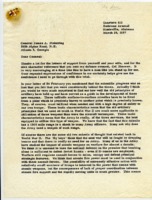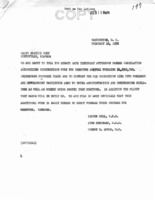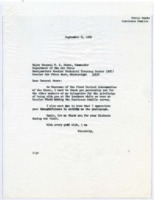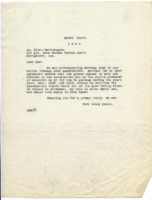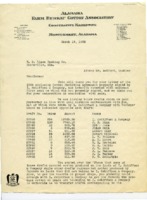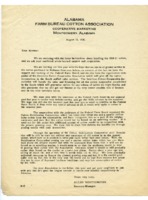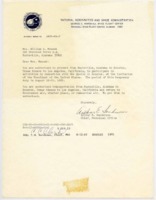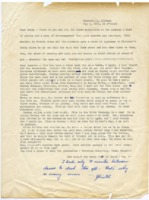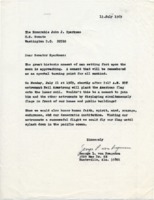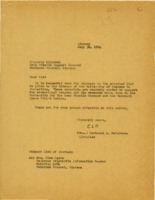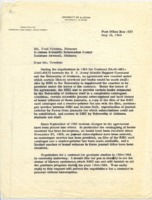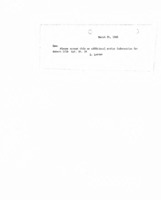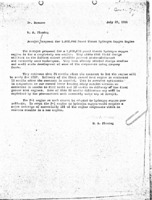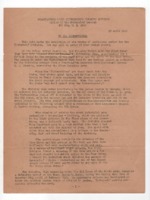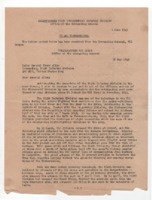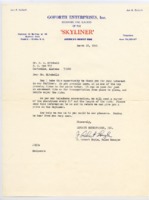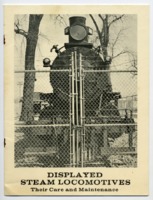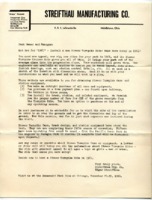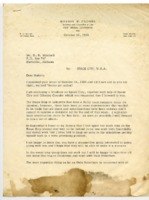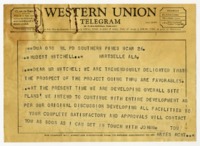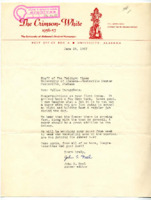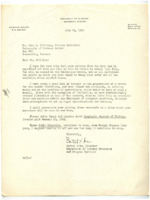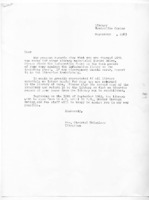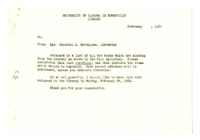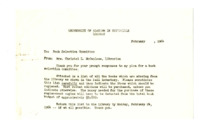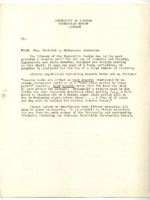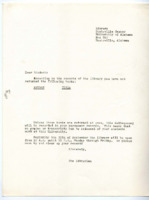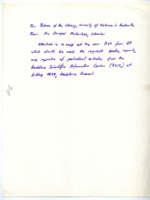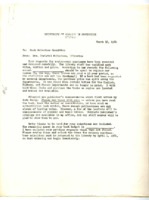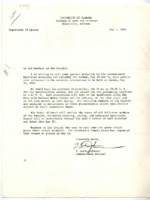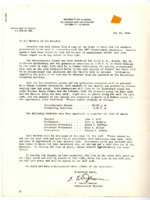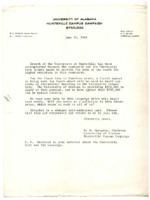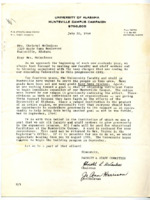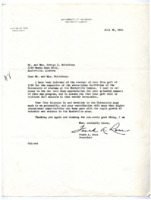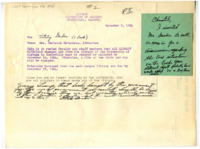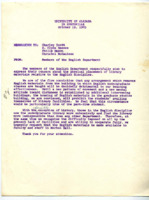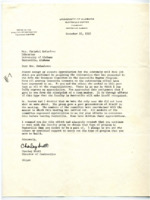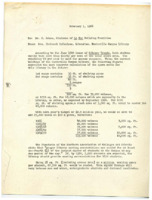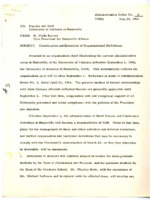
Browse Items (658 total)
Sort by:
-
Letter from Col. John C. Nickerson at Redstone Arsenal in Huntsville, Alabama, to Gen. James A. Pickering in Atlanta, Georgia.
In this letter, Nickerson thanks Gen. Pickering for his support and explains why he believes the Army is the best service branch to develop ballistic missiles. He also discusses the need for missiles in case of war with the Soviet Union. Nickerson was a staff officer at the Army Ballistic Missile Agency at Redstone Arsenal assigned to work on the Jupiter, the United States' first mid-range ballistic missile. He was arrested and court martialed for espionage in 1957 after releasing sensitive documents about the United States missile program to the press. At the time, Secretary of Defense Charles E. Wilson granted the Air Force sole authority to develop intermediate range ballistic missile systems. Nickerson disagreed with this policy, and in response, leaked documents that demonstrated the superiority of Army missiles compared to those developed by the Air Force. He eventually pled guilty to lesser charges and was suspended from the Army for one year and was fined $1,500. Dr. Wernher von Braun was among those who testified on Nickerson's behalf. -
Letter from Sen. Lister Hill, Sen. John Sparkman, and Rep. Bob Jones to Huntsville radio stations.
Addressed to stations WBHP and WFUN, the letter announces that the U. S. Senate passed "legislation authorizing construction work for Redstone Arsenal totaling $4,250,000." The letter also mentions building rocket test stations and a flight test range. -
Materials from Rep. Bob Jones' visit to Keesler Air Force Base in Biloxi, Mississippi after Hurricane Camille.
The materials include correspondence between Jones and Major General T. E. Moore, commander of the Keesler Technical Training Center, and a photo of Jones with Moore, Congressman William Colmer of Mississippi and General Sam Maddux. -
Correspondence between I. Schiffman and Co. in Huntsville, Alabama, and Allen Northington of the Alabama Farm Bureau Cotton Association in Montgomery, Alabama.
From the business records of I. Schiffman and Company. In the first letter, Lawrence B. Goldsmith of I. Schiffman and Co. inquires about selling cotton through the Alabama Farm Bureau Cotton Association. In his reply, Northington asserts that "we will be glad to handle any cotton for you that was grown on your farm and make the government advance up to 15.64� Middling basis." -
Correspondence concerning cooperative marketing of Huntsville-area farmers' cotton.
From the business records of I. Schiffman and Company. The letters contain lists of farmers whose cotton I. Schiffman & Co. is marketing through the Alabama Farm Bureau Cotton Association. The materials include notes from each farmer instructing the Association to hold their cotton in the "regular annual pool [...] subject to lien on same held by I. Schiffman & Company." Each letter indicates the value of the cotton. -
Materials regarding prices and cooperative marketing of the 1930 cotton crop.
From the business records of I. Schiffman and Company. The materials include letters and instructions for handling and delivering the 1930-31 cotton crop to the Alabama Farm Bureau Cotton Association. The instructions describe the different pools available for marketing cotton and lists warehouses throughout Alabama to be used for storing cotton. The last item, a letter from N. S. Stewart, discusses low cotton prices since 1926 and lists advantages of marketing cotton through the Association. -
Report from the Alabama sesquicentennial celebration held in Huntsville, Alabama.
This report was written by Frederic F. Mellen of Jackson, Mississippi. Mellen was a descendant of Arthur F. Hopkins, a Lawrence County delegate to the 1819 constitutional convention. Mellen recounts his experience at the sesquicentennial events on August 2, 1969, including the birthday luncheon and the ceremony commemorating the signing of the 1819 constitution. He notes that "it is pleasing to see and realize how Huntsville has grown, and that now it is a vast educational and scientific research and development center." -
Letter from Arthur E. Sanderson at Marshall Space Flight Center to Berta Mrazek in Huntsville, Alabama.
In the letter, Sanderson authorizes Mrazek to travel to Houston, Texas and Los Angeles, California "to participate in activities in connection with the Apollo 11 mission, at the invitation of the President of the United States." -
Letter from Christel Ludewig in Montevallo, Alabama to Hermann and Emmy Ludewig in Huntsville, Alabama.
In the letter, Christel congratulates her father on the success of Alan Shepard's flight as the first American in space and comments on aspects of her life as a college student. -
Letter from George L. von Pragenau in Huntsville, Alabama to Senator John J. Sparkman in Washington, D.C.
Von Pragenau suggests to Sparkman that residents of Huntsville should display American flags outside their homes and businesses at the same moment that "astronaut Neil Armstrong will plant the American flag onto the lunar soil." He wrote a similar letter to Huntsville mayor Joe Davis. -
Letter from Christel L. McCanless at the UAH Library to the Army Missile Support Command at Redstone Arsenal in Huntsville, Alabama.
In the letter, McCanless requests the transfer of scientific and engineering journals from Redstone to support research and teaching at the University. A list of the journals is enclosed. -
Letter from George W. Croker at the University of Alabama in Tuscaloosa, Alabama, to Fred Croxton, director of the Redstone Scientific Information Center in Huntsville, Alabama.
In the letter, Croxton discusses an agreement made between the University of Alabama and Redstone Scientific Information Center (RSIC) to share library services and materials, including journal subscriptions, messenger service, and access to the RSIC facility. -
Letter from Maj. Gen. Terry Allen to the 104th Infantry "Timberwolf" Division.
In this letter, Allen describes the division's achievements in "six months of continuous combat," detailing its role in the liberation of the Netherlands and the capture of the Ruhr region and Cologne. Allen includes an excerpt from a letter from J. Lawton Collins. -
Letter from Lt. Gen. J. Lawton Collins commending the 104th Infantry "Timberwolf" Division for its role in capturing German territory at the end of World War II.
The letter was forwarded to all members of the division by Maj. Gen. Terry Allen of the 104th Infantry Division. Collins chronicles the Timberwolves' accomplishments in campaigns in western Germany, including the capture of Cologne and the Ruhr region. -
Pamphlet discussing "Displayed Steam Locomotives-Their Care and Maintenance" with attached correspondence.
The correspondence is from J. David Conrad of the Illinois Railway Museum. -
Letter from Streifthau Manufactoring Co. to the park owner.
The letter advertises the "new Streco Turnpike Ride" and discusses the methods the park owner could take to obtain the ride. -
Western Union Telegram from Tom Hayes to Hubert Mitchell.
The telegram discusses the park project development and has a note on the back, presumably written by Mitchell, listing what he needs to discuss with Hayes over a telephone call. -
Letter from the editor of the Crimson-White to the staff of the Twilight Times.
In this letter, John S. Neel, the summer editor of the Crimson-White, the University of Alabama's student newspaper, congratulates the staff of the student-led Twilight Times on their first issue. Neel mentions in the letter how impressive it is that these students are able to produce their paper when they "are just going to school at night and holding down a regular job during the day." -
Letter from Bethel Fite, Director of the Department of Library Extension and Program Services, to library assistant John S. Phillips at the University of Alabama Center in Huntsville.
Fite expresses his regret that Phillips must discontinue his employment at the University of Alabama Center in Huntsville and discusses the state of the University of Alabama System libraries. -
Form letter requesting the return of library materials.
In this letter, librarian Christel McCanless requests that the recipient return any library materials that they have and are no longer using. The letter has spaces for the date, recipient's name, and the materials the recipient needs to return. -
Letter to give notice of a list of books missing from the library.
The letter notes that the books were deemed missing by consulting the fall inventory and that the recipient should carefully examine the list to determine what items should be replaced. -
Letter to the Book Selection Committee to give notice of a list of books missing from the library.
The letter notes that the books were deemed missing by consulting the fall inventory and that the recipient should carefully examine the list to determine what items should be replaced. -
Letter from Christel L. McCanless concerning reserve books.
The letter concerns the use of a reserve shelf for students and faculty used to allow a particular item with few or no copies to be used by multiple individuals. The letter notes that this item cannot be taken from the reserve room. -
Letter to the Book Selection Committee from Christel L. McCanless concerning book replacement purchases.
In the letter, McCanless writes that the book replacement purchase requests have been received and reviewed, and that publisher's announcements and order forms have been attached to the letter. -
Letter from T. Earle Johnson to the University of Alabama faculty.
The letter concerns "the Commencement Excercises scheduled for Saturday and Sunday, May 30 and 31." It provides information about the times and places of the ceremonies and processions and reminds the faculty that their participation is required. -
Letter from M. B. Spragins advertising the University of Alabama Huntsville Campus fundraising campaign.
The letter states that the fundraising goal is $750, 000. -
Letter to Christel L. McCanless requesting she "give generously to the expansion program" fundraiser for the University of Alabama Huntsville campus.
Christel L. McCanless is both the recipient and one of the senders of this letter. -
Library return notice for Vitaliy Garber.
The notice informs Garber, "Since you are no longer teaching at the university, you are not eligible to check books out of the library." It includes a response from Garber and a note from another librarian. -
Memorandum from the English Department to Charley Scott, H. Clyde Reeves, Philip Mason, and Christel McCanless.
In this memo, members of the English Department protest the removal of library materials from Morton Hall to the Graduate Studies Building (later Madison Hall). The writers report their concern that "the housing of English materials in the graduate studies building, we are convinced, will prohibit the students' availing themselves of library facilities." -
Letter from Charley Scott, Director of Instruction, to Christel McCanless, Librarian, at the University of Alabama Huntsville Center.
Scott notes his appreciation for McCanless' adept handling of the "Review of the Development of the Huntsville Campus Library." -
Memorandum from Dr. C. Adams, Chairman of the Ad Hoc Building Committee, to Christel McCanless, Librarian, Huntsville Campus Library.
The memo contains calculations for necessary shelf space and access space in the proposed library building and takes account of collection growth. Includes floor plans and elevations. -
"Administrative Order No. 8."
Sent from H. Clyde Reeves, Vice President for Huntsville Affairs, to all faculty and staff, this order outlines the "current administrative setup in Huntsville of the University of Alabama." The document provides clarification of certain administrative roles, including those of Finance Officer Earl Jacoby, Assistant to the Vice President and Director of Community Relations Philip M. Mason, and Director of Instruction Charley Scott. The order also outlines the structure of academic departments, roles of department chairs, and the organization of the Research Institute. It includes an organizational chart of the university, and pencilled notes have been added by then-head librarian Christel L. McCanless.
